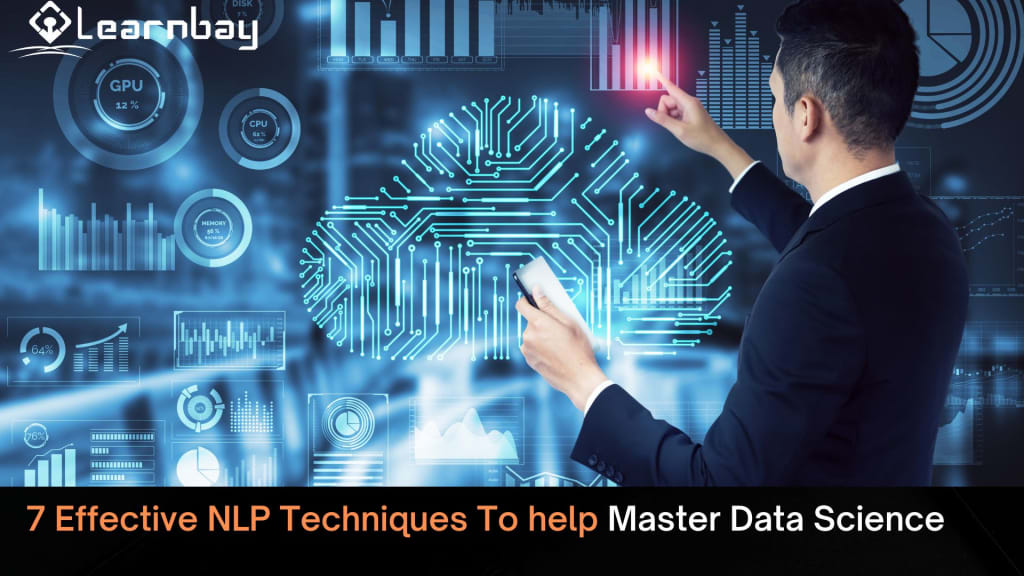7 Effective NLP Techniques To help Master Data Science
Data science has become the latest buzzword in recent years.

From traditional data mining and big data to machine learning and artificial intelligence, data-driven decision-making is now a daily routine for many businesses as they deal with information in abundance.
However, not all business problems can be solved by these advanced techniques. In some cases, an old-fashioned technique of Natural Language Processing (NLP) can be quite helpful. Since the World Wide Web opened up new opportunities for online communication, many companies have begun using human language to express their ideas and thoughts through websites, blogs and social media channels. This makes it easier for customers to understand what you have to offer and information about your products or services.
In this article, I'll review some of the most important NLP methods available and give you an idea of how to use them in your everyday data analysis.
What is NLP?
Natural language processing (NLP) is the branch of computer science that deals with designing and developing algorithms that process human language. NLP has applications in speech recognition, information retrieval, question-answering systems, machine translation and text analysis, computational linguistics and others.
In data science, NLP techniques are used to analyze and interpret the contents of the text. The first step in this process is to break down each word into its components and then assign a meaning to each component.
After this step, you can use ML algorithms to determine which words are more likely to occur together or in what order. This can be useful for identifying recurring topics within text or even spotting patterns that may have been missed by less sophisticated methods such as manual curation.
Uses of Natural Language Processing (NLP):
NLP techniques are useful in many areas of business and technology. For example:
NLP can help you process text data to be used for further analysis and processing. For example, natural language processing is used in search engines to understand what users want and need from the search results.
NLP can also help you identify non-native speakers by identifying their accents or dialect in their speech. This can be very useful when working with customer support teams with customers from around the world.
In medicine, NLP can help doctors diagnose diseases by analyzing medical records written by patients with specific symptoms or signs.
In law enforcement, NLP can help officers locate suspects by analyzing voice recordings of people speaking over the phone or during an interrogation session (such as a police interrogation or courtroom questioning).
Grab a popular machine learning course in Chennai if you want to get a more in-depth understanding of NLP and the techniques that are associated with it.
Top NLP Techniques:
Some of the popular NLP techniques include:
Tokenization:
In NLP, tokenization is one of the most basic and straightforward techniques. Tokenization is a critical step in any NLP application's preparation of the text. It is necessary to tokenize lengthy text strings in order to break them down into smaller units, such as letters, numbers, and other symbols.
When creating an NLP model, these tokens serve as a foundation for a better understanding of the situation. "Blank space" is a common separator for tokens in tokenizers.
Tokenization techniques in NLP vary depending on the language and modeling goal.
Rule-Based Tokenization
Spacy Tokenizer
White Space Tokenization
Penn Tree Tokenization
Subword Tokenization
Dictionary Based Tokenization
Stemming and Lemmatization:
Stemming and lemmatization are two of the most common first steps in building an NLP project. These are the first strategies you use on the path to becoming a master in NLP.
Stemming:
Stemming is a set of algorithms that function by slicing off the end of the beginning of a word to get to its infinitive form. To achieve this, these programs look at common prefixes and suffixes in the language being analyzed. In certain cases, removing the unnecessary words will result in the right infinitive form. The Porter stemmer is the most often used stemming algorithm in English. The root of a word may be found using this algorithm's five steps.
Lemmatization:
For linguistic analysis algorithms to work correctly, each word's lemma must accurately be extracted. Lemmatization techniques were developed to solve the limitations of stemming. To extract a word's infinitive form, these algorithms require certain linguistic and grammatical information to be input into the algorithm. As a result, they frequently require the use of a linguistic dictionary in order to classify each word appropriately.
Developing a lemmatizer is more difficult and time-consuming than building a stemmer, as you can see from these definitions. However, the findings will be more accurate and less prone to errors.
Keyword Extraction:
An NLP technique known as keyword extraction, or "keyword identification" or "keyword analysis," is used for text analysis. The primary aim of this model is to mechanically extract from a text the most frequently occurring words and sentences. This technique is frequently employed as a first stage in summarizing and delivering the important concepts contained in a book.
Interestingly, the strength of machine learning and AI lies in the backend of keyword extraction techniques. Extract and simplify a given text to make it easier for the machine to comprehend. The algorithm may be utilized in any situation, from academic material to social media posts, and it can be customized to any form of language.
Social media monitoring, customer service, product research, and search engine optimization are just a few of the numerous uses of keyword extraction today.
NER (Named Entity Recognition):
Like stemming and lemmatization, NLP's fundamental and core procedures are termed entity recognition or NER. NER is a method used to extract entities from a text body to identify basic ideas, such as names, locations, dates, etc.
In the NER algorithm, there are only two main phases. The first step is to identify an entity in the text and then classify it into a single category. The quality of the training data used to construct the NER model has a substantial impact on its performance. The training data should be as close as feasible to the real data in order to produce the most accurate results.
NER can be utilized in various domains, including developing recommendation systems, improving patient care in health care, and providing appropriate study materials to college students.
Sentiment Analysis:
Sentiment analysis is undoubtedly the most popular and widely used NLP technique. The fundamental role of this method is to extract the sentiment behind a body of text by evaluating the containing words.
The purpose is to categorize any writing on the internet into one of three categories: positive, negative, or neutral. The prominent use of sentiment analysis is to reduce the amount of hate speech on social media and to identify customers who are upset by bad reviews.
Among the many uses of machine learning techniques, sentiment analysis is one of the most powerful. It can be executed using either supervised or unsupervised methods. The Naive Bayes algorithm is maybe the most prevalent supervised approach for performing sentiment analysis. Additional supervised ML methods include random forest and gradient boosting.
Text Summarization:
One of the most effective uses of NLP is text summarization. That condenses a vast body of text into a smaller chunk carrying the text's primary point. This strategy is widely used in large news pieces to summarize research studies.
Text summarizing is an advanced technique that relies on methods like topic modeling and keyword extraction to achieve its aims. Extraction and abstraction are two of the steps necessary to do this process.
Extraction involves using algorithms to pull out relevant text passages and categorizing them according to how frequently they occur. The algorithm then creates a second summary by constructing a new text that delivers the same meaning as the original text.
LexRank and TextRank are two popular examples of text summarization algorithms.
Topic Modeling:
NLP technique Topic Modeling analyzes a corpus of text documents to discover the topics that are embedded in them. What's even better is that topic modeling is a machine learning approach that doesn't require any labeling of the documents. A human annotation would be unable to arrange and summarize such a large number of electronic archives using this method.
Multiple algorithms may be used to represent a text subject, like the correlated topic model, latent sentiment analysis, and latent dirichlet allocation. The commonly used technique is the Latent Dirichlet. This technique examines the text, breaks it down into words and statements, and then extracts distinct subjects from these words and phrases. All you need to do is give it a piece of text, and the algorithm will take care of the rest for you.
Summary:
If we are to build a model that makes accurate predictions, we must use the most powerful techniques data science has to offer. NLP techniques are an immensely important component of any data science project, and they should be used in all but the simplest cases. In fact, most software projects may require at least one NLP technique. If you want to build predictive models that work well, don't underestimate the power of NLP techniques.
So, to sum up, NLP has great potential in the world of data science, and we have seen that using these techniques can have an impact on visualizations. Furthermore, if you are Interested in pursuing a career in data science, head over to a data science course in Chennai for more information on NLP and its techniques used in real-world projects.
About the Creator
Data science blogger
I am mallikarjun , a data science enthusiast and passionate blogger who loves to write about data science and latest technologies. I always believe in smart learning processes that help people understand concepts better,
Enjoyed the story? Support the Creator.
Subscribe for free to receive all their stories in your feed. You could also pledge your support or give them a one-off tip, letting them know you appreciate their work.






Comments
There are no comments for this story
Be the first to respond and start the conversation.